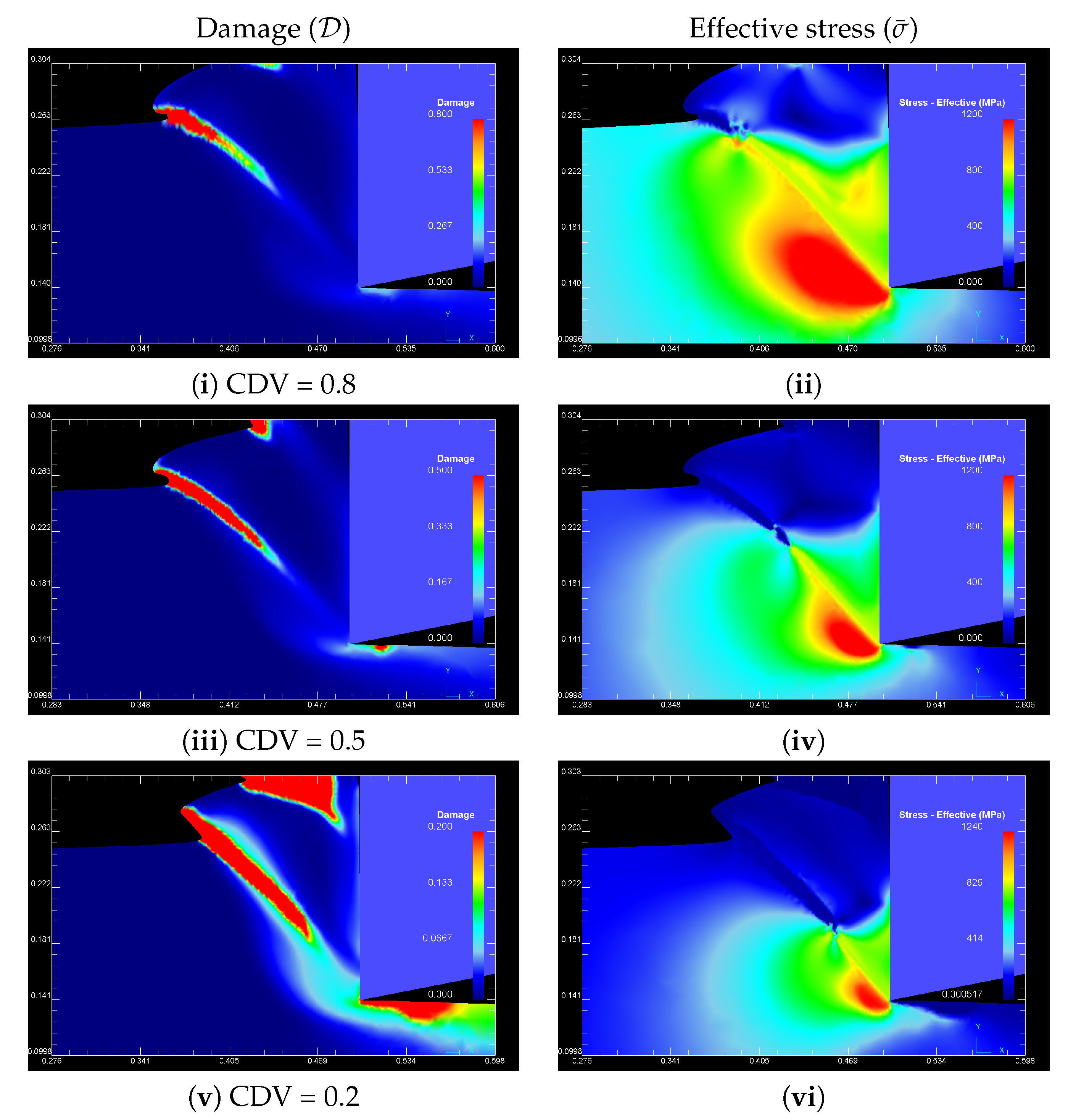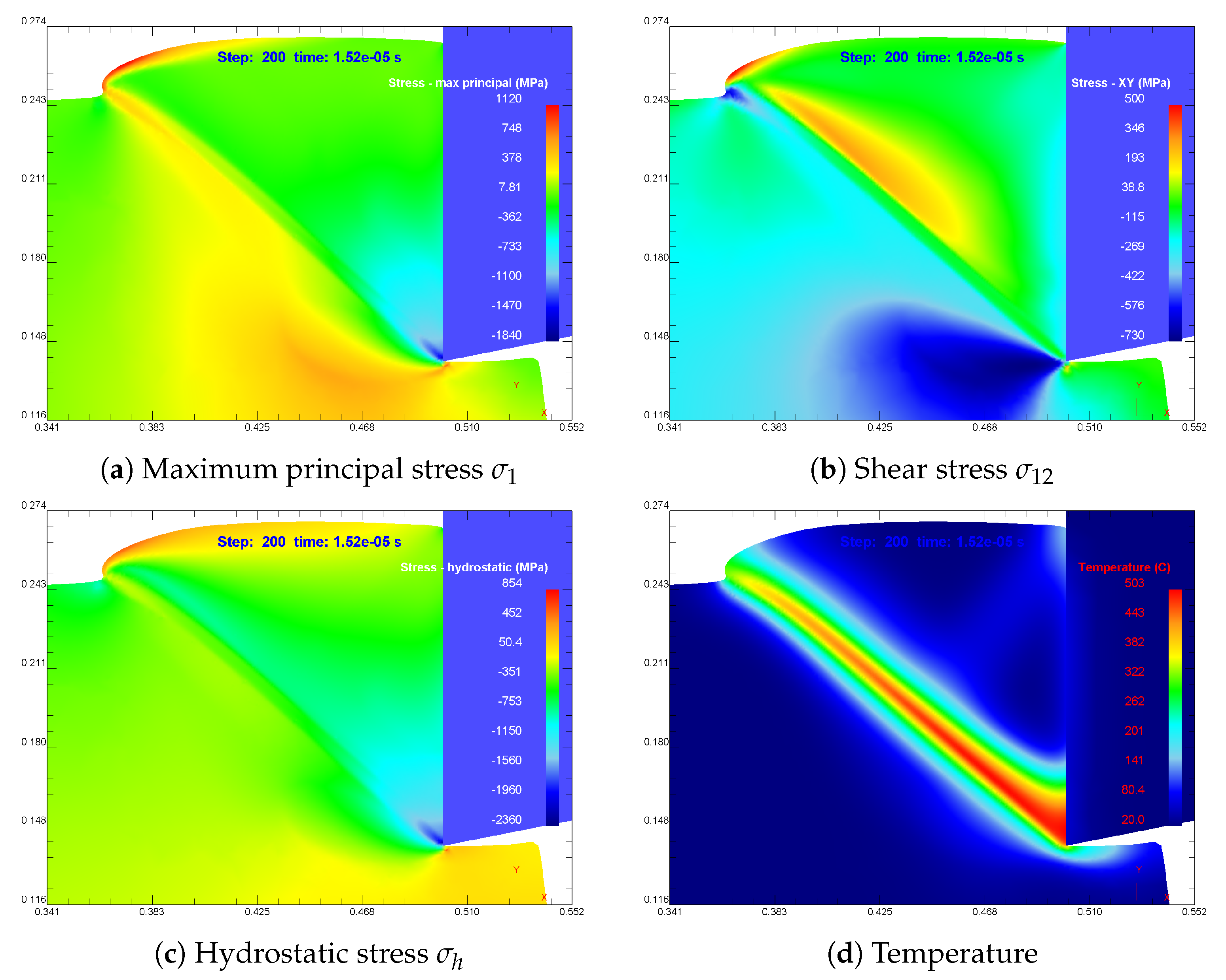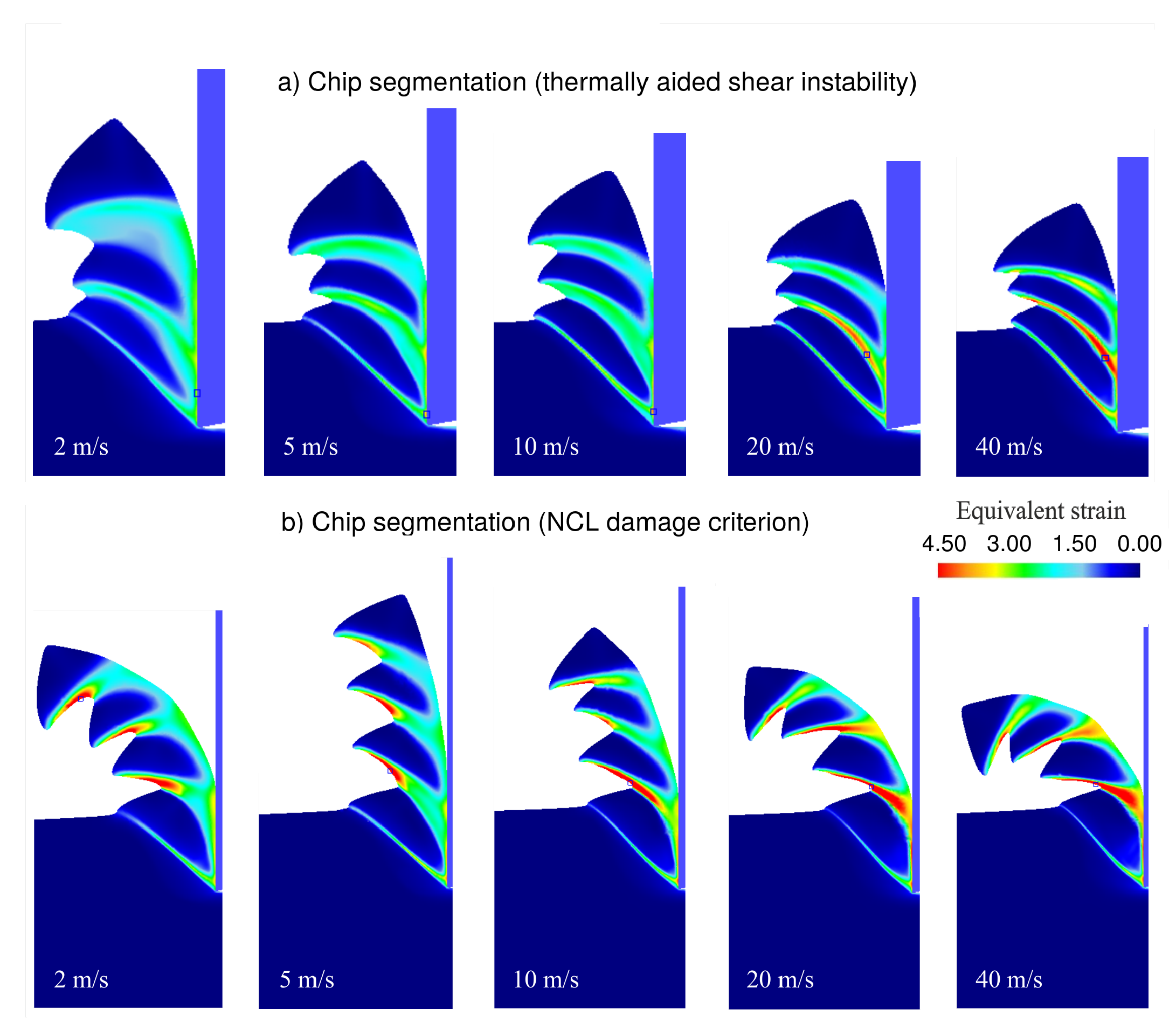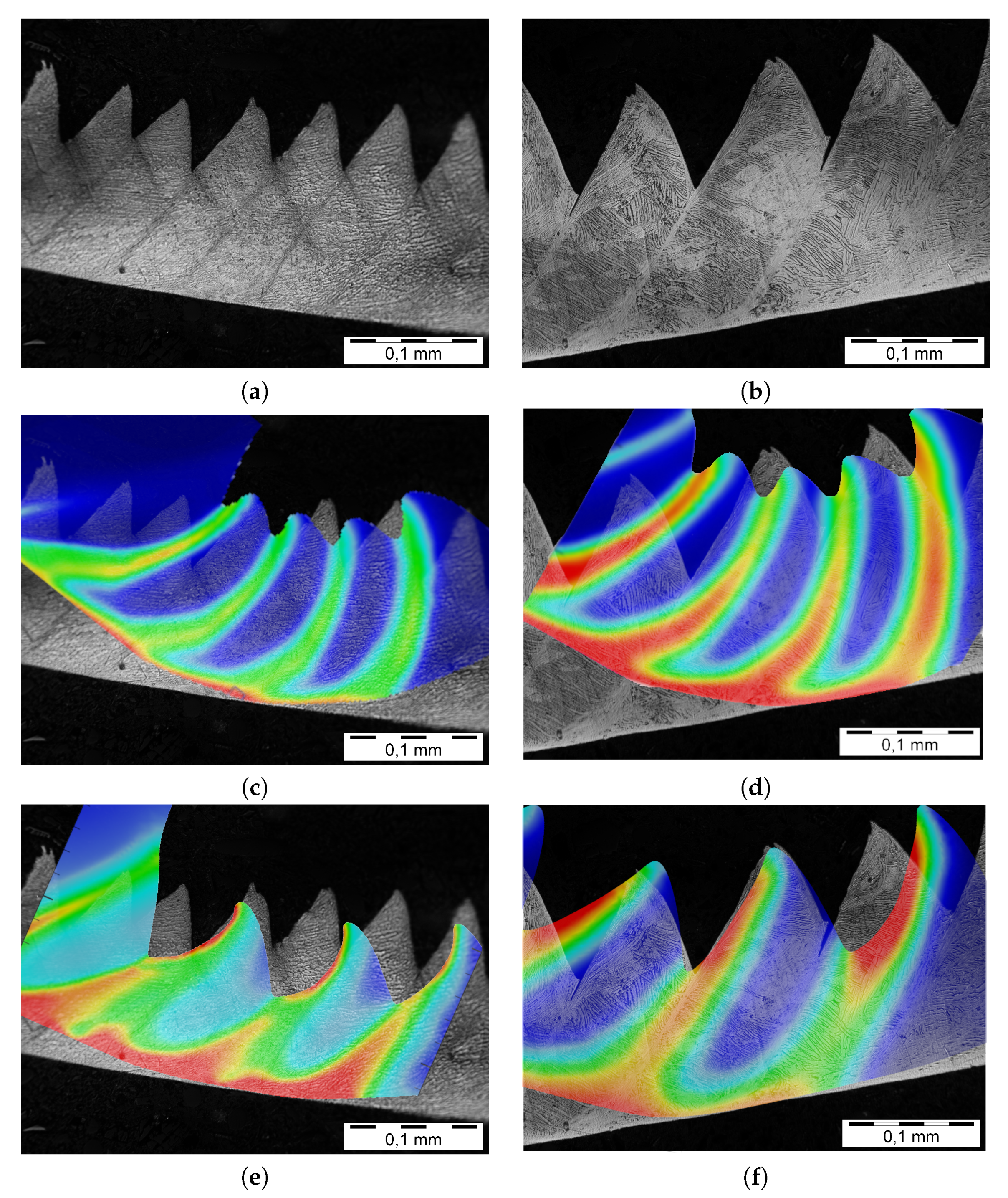Simulation of Adiabatic Shear Bands in Orthogonal Machining of Ti6Al4V Using a Rigid-Viscoplastic Finite Element Analysis
Abstract
1. Introduction
2. FEM Modeling of High Speed Material Processing
2.1. Rigid-ViscoPlastic Formulation
2.1.1. Weak Form
2.1.2. Heat Equation
2.2. Remeshing and Adaptive Meshing
2.3. FEM Model, Material Flow Stress, Thermomechanical Properties and Boundary Conditions
3. ASB Formation under Thermally Aided Shear Instability
3.1. Catastrophic Thermoplastic Slip
3.2. Numerical Investigations
4. ASB Formation Using a Ductile Damage Model
4.1. Damage Modeling
4.2. Numerical Investigations
5. Further Numerical Observations
5.1. Nucleation, Growth and Coalescence of Discontinuous Degraded Element Sets within an ASB
- Initiation of localized degradation at elements withing the ASB and in the neighboring area around the primary shear zone (Figure 8a).
- Damage localization in elements inside the ASB (Figure 8b);
- Severe damage localization of elements within the ASB–Discontinuous element degradation pattern inside the ASB (Figure 8c);
- Coalescence of degraded elements forming a macrocrack within the ASB, i.e., = CDV (Figure 8d).
5.2. Temperature Field inside a Well Formed ASB
5.3. Temperature Reflection
5.4. Fields of State Variables during ASB Formation
5.5. Chip Formation in Various Cutting Speeds
6. Orthogonal Cutting Experiments of Ti6Al4V
7. Synopsis and Perspectives
- The synergistic effect of the thermally aided shear instability and ductile damage on ASB formation and evolution is numerically investigated. Simulations show that ductile damage within the ASB is a post-localization failure mechanism occurring after intense shear localization.
- Simulations under different cutting conditions successfully predict cases in which damage initiated near the free surface but also ones that occur randomly everywhere within the ASB as well as near the tool tip. This result is bridging contradicting theories regarding the damage initiation regions.
- Detailed simulations using the NCL ductile damage model revealed an array of discontinuous degraded elements of nearly ellipsoidal shapes, which grows and progressively coalescence forming a macro crack inside the ASB.
- Numerical simulations predict that the chip segmentation frequency over the range of the numerically examined speeds, m/s (feed = 0.08 mm/rev), presents a slope of approximately equal to 1 (in a log-log diagram) which indicates that the segmentation frequency is proportional to speed () for both models.
- In the limited range of examined cutting conditions, the estimated FEM mean forces are in good correlation with the ones measured in the experiments.
- Experimental results based on chip morphology confirm that thermally aided shear instability cannot predict accurately the saw-tooth geometry at the low speed regime. This fact suggests that a damage mechanism during the last stages of ASB evolution is susceptible for the chip form at the free boundary.
- Superposition of the FEM chips on experimental optical micrographs show discrepancies regarding the predicted plastic deformation for both models.
- The initiation and propagation of the ASB cannot be deemed as sensitive to mesh alignment. On the other hand, and as expected, the ASB formation with the introduction of the ductile damage criterion can be considered as extremely sensitive to the mesh size.
- Finally, the spatial discretization used in FEM simulations cannot confirm the existence of a turbulent temperature field within a well developed ASB. Determination of the temperature field state in ASBs (laminar or turbulent) is still an open problem which has to be further studied numerically.
Author Contributions
Funding
Acknowledgments
Conflicts of Interest
References
- Zener, C.; Hollomon, J.H. Effect of strain rate upon plastic flow of steel. J. Appl. Phys. 1944, 15, 22–32. [Google Scholar] [CrossRef]
- Recht, R.F. Catastrophic Thermoplastic Shear. Trans. ASME 1964, 31, 189–193. [Google Scholar] [CrossRef]
- Shaw, M.C.; Vyas, A. Chip Formation in the Machining of Hardened Steel. Ann. CIRP 1993, 42/1, 29–33. [Google Scholar] [CrossRef]
- Komanduri, R.; Turkovich, B.F. New observations on the mechanism of chip formation when machining titanium alloys. Wear 1981, 69, 179–188. [Google Scholar] [CrossRef]
- Nakayama, K. The formation of saw tooth chips. In Proceedings of the International Conference on Production Engineering, Tokyo, Japan, 26–29 August 1974; pp. 572–577. [Google Scholar]
- Nakayama, K.; Arai, M.; Kanda, T. Machining characteristics of hard materials. Ann. CIRP 1988, 37, 89–92. [Google Scholar] [CrossRef]
- Vyas, A.; Shaw, M.C. Mechanics of shaw-tooth chip formation in metal cutting. J. Manuf. Sci. Eng. 1999, 121, 163–172. [Google Scholar] [CrossRef]
- Bai, Y.; Dodd, B. Adiabatic Shear Localization; Pergamon: Oxford, UK, 1992. [Google Scholar]
- Wright, T.W. The Physics and Mathematics of Adiabatic Shear Bands; Cambridge Monographs on Mechanics; Cambridge University Press: Cambridge, UK, 2002. [Google Scholar]
- Komanduri, R. Some clarifications on the mechanics of chip formation when machining titanium alloys. Wear 1982, 76, 15–34. [Google Scholar] [CrossRef]
- Rogers, H.C. Adiabatic plastic deformation. Annu. Rev. Mater. Sci. 1979, 9, 283–311. [Google Scholar] [CrossRef]
- Rogers, H.C.; Shastry, C.V. Material Factors in Adiabatic Shearing in Steels. In Shock Waves and High-Strain-Rate Phenomena in Metals; Meyers, M.A., Murr, L.E., Eds.; Springer: Boston, MA, USA, 1981. [Google Scholar]
- Timothy, S.P.; Hutchings, M. The structure of adiabatic shear bands in a titanium allloy. Acta Met. 1985, 33, 667–676. [Google Scholar] [CrossRef]
- Landau, P.; Osovski, S.; Venkert, A.; Gartnerova, V.; Rittel, D. The genesis of adiabatic shear bands. Sci. Rep. 2016, 6, 37226. [Google Scholar] [CrossRef]
- Sutter, G.; List, G. Very high speed cutting of Ti–6Al–4V titanium alloy-change in morphology and mechanism of chip formation. Int. J. Mach. Tools Manuf. 2013, 66, 37–43. [Google Scholar] [CrossRef]
- Navarro, P.F.; Chiu, P.H.; Higgins, A.; Serge, M.; Benson, D.J.; Nesterenko, V.F. Shear band patterning and post-critical behavior in AISI 4340 steel with different microstructure. Int. J. Impact Eng. 2018, 112, 144–154. [Google Scholar] [CrossRef]
- Komanduri, R.; Hou, Z.B. On Thermoplastic Shear Instability in the Machining of a Titanium Alloy (Ti-6Al-4V). Metall. Mater. Trans. A 2002, 33A, 2995–3010. [Google Scholar] [CrossRef]
- Molinari, A.; Soldani, X.; Miguélez, M.H. Adiabatic shear banding and scaling laws in chip formation with application to cutting of Ti-6Al-4V. J. Mech. Phys. Solids 2013, 61, 2331–2359. [Google Scholar] [CrossRef]
- Shivpuri, R.; Hua, J.; Srivastava, P.M.A.K.; Lahoti, G.D. Microstructure-Mechanics Interactions in Modeling Chip Segmentation during Titanium Machining. CIRP Ann. 2002, 51, 71–74. [Google Scholar] [CrossRef]
- Baker, M. The influence of plastic properties on chip formation. Comput. Mater. Sci. 2003, 28, 556–562. [Google Scholar] [CrossRef]
- Calamaz, M.; Coupard, D.; Girot, F. A new material model for 2D numerical simulation of serrated chip formation when machining titanium alloy Ti–6Al–4V. Int. J. Mach. Tools Manuf. 2008, 48, 275–288. [Google Scholar] [CrossRef]
- Belytschko, T.; Krongauz, Y.; Organ, D.; Fleming, M.; Krysl, P. Meshless methods: An overview and recent developments. Comput. Methods Appl. Mech. Eng. 1996, 139, 3–47. [Google Scholar] [CrossRef]
- Duarte, C.A.; Oden, J.T. An hp adaptive method using clouds. Comput. Methods Appl. Mech. Eng. 1996, 139, 237–262. [Google Scholar] [CrossRef]
- Babuska, I.; Melenk, J.M. The partition of unity method. Int. J. Numer. Methods Eng. 1997, 40, 727–758. [Google Scholar] [CrossRef]
- Gingold, R.A.; Monaghan, J.J. Smoothed Particle Hydrodynamics: Theory and Application to Non-Spherical Stars. Mon. Not. R. Astron. Soc. 1977, 181, 375–389. [Google Scholar] [CrossRef]
- Liu, W.K.; Chen, Y.; Jun, S.; Chen, J.S.; Belytschko, T.; Pan, C.; Uras, R.A.; Chang, C.T. Overview and Applications of the Reproducing Kernel Particle Methods. Arch. Comput. Methods Eng. State Art Rev. 1996, 3, 3–80. [Google Scholar] [CrossRef]
- Chen, J.-S. Cristina Maria Oliveira Lima Roque, Chunhui Pan, Sérgio Tonini Button, Analysis of metal forming process based on meshless method. J. Mater. Process. Technol. 1998, 80–81, 642–646. [Google Scholar] [CrossRef]
- DEFORM-2D. Scientific Forming Technologies Corporation, Version 10.2 User’s Manual; Scientific Forming Technologies Corporation: Columbus, OH, USA, 2011. [Google Scholar]
- Hill, R. The Mathematical Theory of Plasticity; Oxford University Press: London, UK, 1971. [Google Scholar]
- Zienkiewicz, O.C.; Godbole, P.O. Flow of plastic and visco-plastic solids with special reference to extrusion and forming processes. Int. J. Numer. Methods Eng. 1974, 8, 3–16. [Google Scholar] [CrossRef]
- Kobayashi, S.; Oh, S.I.; Altan, T. Metal Forming and the Finite-Element Method; Oxford University Press: London, UK, 1989. [Google Scholar]
- Rebelo, N.; Kobayashi, S. A Coupled Analysis of Viscoplastic Deformation and Heat Transfer—I. Int. J. Mech. Sci. 1980, 22, 699. [Google Scholar] [CrossRef]
- Rebelo, N.; Kobayashi, S. A Coupled Analysis of Viscoplastic Deformation and Heat Transfer—II. Int. J. Mech. Sci. 1980, 22, 707. [Google Scholar] [CrossRef]
- Marusich, T.D.; Ortiz, M. Modeling and Simulation of High-Speed Machining. Int. J. Numer. Methods Eng. 1995, 38/21, 3675–3694. [Google Scholar] [CrossRef]
- Ortiz, M.; Leroy, Y.; Needleman, A. A finite element method for localized failure analysis. Comput. Methods Appl. Mech. Eng. 1987, 61, 189–214. [Google Scholar] [CrossRef]
- Fish, J.; Belytschko, T. Elements with embedded localization zones for large deformation problems. Comput. Struct. 1988, 30, 247. [Google Scholar] [CrossRef]
- El-Magd, E.; Treppmann, C. Simulation of Chip Root Formation at High Cutting Rates by Means of Split-Hopkinson Bar Test. Mater. Ger. Journal: Mater. Test. 1999, 41/11, 457–460. [Google Scholar]
- Treppmann, C. Flieverhalten metallischer Werkstoffe bei Hochgeschwindigkeitsbeanspruchung. Ph.D. Thesis, RWTH, Aachen, Germany, 2001. [Google Scholar]
- Taylor, G.I.; Quinney, H. The latent energy remaining in a metal after cold working. Proc. R. Soc. Lond. A 1934, 143, 307–326. [Google Scholar]
- Mason, J.J.; Rosakis, A.J.; Ravichandran, G. On the strain and strain rate dependence of the fraction of plastic work converted to heat: An experimental study using high speed infrared detectors and the Kolsky bar. Mech. Mater. 1994, 17, 135–145. [Google Scholar] [CrossRef]
- Kapoor, R.; Nemat-Nasser, S. Determination of temperature rise during high strain rate deformation. Mech. Mater. 1998, 27, 1–12. [Google Scholar] [CrossRef]
- Nemat-Nasser, S.; Guo, W.G.; Nesterenko, V.F.; Indrakanti, S.S.; Gu, Y.B. Dynamic response of conventional and hot isostatically pressed Ti6Al4V alloys: Experiments and modeling. Mech. Mater. 2001, 33, 425–439. [Google Scholar] [CrossRef]
- Duncan, A.S.; Macdougall, P.; Maudlin, J. The proportion of plastic work converted to heat in Ti-6Al-4V: MTS model prediction and experimental data. In Proceedings of the Explomet 2000, Albuquerque, NM, USA, 19–23 June 2000. [Google Scholar]
- Rosakis, P.; Rosakis, A.J.; Ravichandran, G.; Hodowany, J. A thermodynamic internal variable model for the partition of plastic work into heat and stored energy in metals. J. Mech. Phys. Solids 2000, 48, 581–607. [Google Scholar] [CrossRef]
- Childs, T.H.; Dirikolu, M.H.; Sammons, M.D.S.; Maekawa, K.; Kitagawa, T. Experiments on and Finite Element Modeling of Turning Free-Cutting Steels at Cutting Speeds up to 250 m/min. In Proceedings of the 1st French and German Conference on High-speed Machining, Metz, France, June 1997; pp. 325–331. [Google Scholar]
- Wright, P.K.; Horne, J.G.; Tabor, D. Boundary Conditions at the Chip-Tool Interface in Machining: Comparisons Between Seizure and Sliding Friction. Wear 1979, 54, 371–390. [Google Scholar] [CrossRef]
- Samiatin, S.L.; Rao, S.B. Shear localization during metal cutting. J. Mater. Sci. Eng. 1983, 61, 185–192. [Google Scholar] [CrossRef]
- Marchand, A.; Duffy, J. An experimental study of the formation process of adiabatic shear bands in a structural steel. J. Mech. Phys. Solids 1988, 36, 251–283. [Google Scholar] [CrossRef]
- Medyanik, S.N.; Liu, W.K.; Li, S. On criteria for dynamic adiabatic shear band propagation. J. Mech. Phys. Solids 2007, 55, 1439–1461. [Google Scholar] [CrossRef]
- Lee, D. The effect of cutting sped on chip formation under orthogonal machining. J. Eng. Ind. Trans. ASME 1985, 107, 55–63. [Google Scholar] [CrossRef]
- Grebe, H.A.; Pak, H.R.; Meyers, M.A. Adiabatic shear localization in titanium and Ti6Al4V alloy. Met. Trans. A 1985, 16A, 761–775. [Google Scholar] [CrossRef]
- Kailas, S.V.; Prasad, Y.V.R.K.; Biswas, S.K. Flow instabilities and fracture in Ti-6Al-4V deformed in compression at 298-673 K. Metall. Mater. Trans. A 1994, 25A, 2173–2179. [Google Scholar] [CrossRef]
- Schoenfeld, S.E.; Wright, T.W. A failure criterion based on material instability. Int. J. Solids Struct. 2003, 40, 3021–3037. [Google Scholar] [CrossRef]
- Cockcroft, M.G. Ductility; American Society for Metals: Metals Park, OH, USA, 1968; pp. 199–226. [Google Scholar]
- Cockcroft, M.G.; Latham, D.J. Ductility and workability of materials. J. Inst. Met. 1968, 96, 33–39. [Google Scholar]
- Oh, S.I.; Kobayashi, S.; Chen, C.C. Ductile fracture in axisymmetric extrusion and drawing. J. Eng. Ind. ASME 1979, 101. [Google Scholar] [CrossRef]
- Avitzur, B. Metal Forming Process and Analysis; Mc Graw Hill Book Company: New York, NY, USA, 1968. [Google Scholar]
- Affouard, J.L.; Dormeval, R.; Stelly, M.; Ansart, J.P. Adiabatic shear bands in metals and alloys under dynamic compressive conditions. In Proceedings of the Third Conference on the Mechanical Properties at High Rates of Strain, Oxford, UK, 9–12 April 1984; Harding, J., Ed.; Institute of Physics: Bristol, UK, 1984; pp. 533–540. [Google Scholar]
- Giovanola, J. Adiabatic shear banding under pure shear loading. 1. Direct observation of strain localization and energy measurements. Mech. Mater. 1988, 7, 59–71. [Google Scholar] [CrossRef]
- Giovanola, J. Adiabatic shear banding under pure shear loading. 2. Fractographic and metallographic observations. Mech. Mater. 1988, 7, 72–87. [Google Scholar] [CrossRef]
- Cotterell, M.; Byrne, G. Dynamics of chip formation during orthogonal cutting of titanium alloy Ti-6Al-4V. CIRP Ann. Manuf. Technol. 2008, 57, 93–96. [Google Scholar] [CrossRef]
- Xue, Q.; Meyers, M.A.; Nesterenko, V.F. Self-organization of shear bands in titanium and Ti-6Al-4V alloy. Acta Mater. 2002, 50, 575–596. [Google Scholar] [CrossRef]
- Lee, W.-S.; Lin, C.-F. Plastic deformation and fracture behaviour of Ti–6Al–4V alloy loaded with high strain rate under various temperatures. Mater. Sci. Eng. 1998, A241, 48–59. [Google Scholar] [CrossRef]
- Lee, W.-S.; Lin, C.-F. High-temperature deformation behaviour of Ti6Al4V alloy evaluated by high strain-rate compression tests. J. Mater. Process. Technol. 1998, 75, 127–136. [Google Scholar] [CrossRef]
- Wright, T.W.; Ravichandran, G. Canonical aspects of adiabatic shear bands. Int. J. Plast. 1997, 13, 309–325. [Google Scholar] [CrossRef]
- Molinari, A.; Leroy, Y.M. Existence And Stability Of Stationary Shear Bands With Mixed-Boundary Conditions. Comptes Rendus L’AcadéMie Des Sci. 1990, 310, 1017–1023. [Google Scholar]
- Gioia, G.; Ortiz, M. The two-dimensional structure of dynamic boundary layers and shear bands in thermoviscoplastic solids. J. Mech. Phys. Solids 1996, 44, 251–292. [Google Scholar] [CrossRef]
- Guduru, P.R.; Ravichandran, G.; Rosakis, A.J. Observations of transient temperature vortical microstructures in solids during adiabatic shear banding. Phys. Rev. E 2001, 64, 036128. [Google Scholar] [CrossRef]
- Guduru, P.R.; Rosakis, A.J.; Ravichandran, G. Dynamic shear bands: An investigation using high speed optical and infrared diagnostics. Mech. Mater. 2001, 33, 371–402. [Google Scholar] [CrossRef]
- Li, S.; Liu, W.K.; Rosakis, A.J.; Belytschko, T.; Hao, W. Mesh-free Galerkin simulations of dynamic shear band propagation and failure mode transition. Int. J. Solids Struct. 2002, 39, 1213–1240. [Google Scholar] [CrossRef]
- Yang, Q.; Liu, Z.; Shi, Z.; Wang, B. Analytical modeling of adiabatic shear band spacing for serrated chip in high-speed machining. Int. J. Adv. Manuf. Technol. 2014, 71, 1901–1908. [Google Scholar] [CrossRef]





















| Content | C | Fe | N | Al | V | O | Ti |
|---|---|---|---|---|---|---|---|
| Composition | 0.0023 | 0.160 | 0.007 | 6.190 | 4.080 | 0.180 | Balance |
| Hardness (HRC) | Density (g/cm) | Re (MPa) | Rm (MPa) | k (W/mk) |
|---|---|---|---|---|
| 36 | 4.43 | 910 | 1000 | 6.7 |
© 2020 by the authors. Licensee MDPI, Basel, Switzerland. This article is an open access article distributed under the terms and conditions of the Creative Commons Attribution (CC BY) license (http://creativecommons.org/licenses/by/4.0/).
Share and Cite
Friderikos, O.; Sagris, D.; David, C.N.; Korlos, A. Simulation of Adiabatic Shear Bands in Orthogonal Machining of Ti6Al4V Using a Rigid-Viscoplastic Finite Element Analysis. Metals 2020, 10, 338. https://doi.org/10.3390/met10030338
Friderikos O, Sagris D, David CN, Korlos A. Simulation of Adiabatic Shear Bands in Orthogonal Machining of Ti6Al4V Using a Rigid-Viscoplastic Finite Element Analysis. Metals. 2020; 10(3):338. https://doi.org/10.3390/met10030338
Chicago/Turabian StyleFriderikos, Orestis, Dimitrios Sagris, Constantine N. David, and Apostolos Korlos. 2020. "Simulation of Adiabatic Shear Bands in Orthogonal Machining of Ti6Al4V Using a Rigid-Viscoplastic Finite Element Analysis" Metals 10, no. 3: 338. https://doi.org/10.3390/met10030338
APA StyleFriderikos, O., Sagris, D., David, C. N., & Korlos, A. (2020). Simulation of Adiabatic Shear Bands in Orthogonal Machining of Ti6Al4V Using a Rigid-Viscoplastic Finite Element Analysis. Metals, 10(3), 338. https://doi.org/10.3390/met10030338






